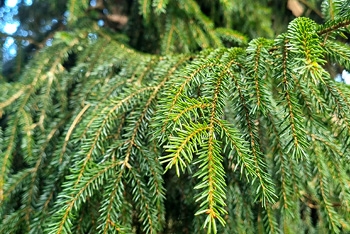Tree of the month: Oriental spruce
Oriental spruce - Piceaorientalis
Native to the Caucasus and the Pontic Mountains of northeastern Turkey, (Picea orientalis) is among the most attractive spruces, with a dense form with short branches. Like all spruces, it has pendulous cones, concentrated towards the top of the tree, and needles attached to their branchlets by small, woody ‘pegs’. Technically known as pulvini, these pegs remain on the shoot once needles are removed, intentionally or otherwise. A closer inspection of the needles of Oriental spruce is always advised: they are distinctively short – typically less than 1cm – and are in fact the shortest of all the spruces. Introduced in 1839, the species attains up to 50 metres in the wild, though in cultivation is typically little more than half that height.

We’ve numerous examples of Oriental spruce in the collection worthy of closer study; including giant specimens on both Pool Avenue and Specimen Avenue, and between Holford and Morley Rides, in the Old Arboretum. The tip of the former, on Pool Avenue, leans away from the neighbouring Norway maple whose crown has spread across from the other side of the ride. Young plants collected on an expedition to Turkey in 2005 are growing well elsewhere in the Old Arboretum, between Loop Walk and Jackson Avenue, while plants of Russian origin grow along The Link. ‘Aurea’, a cultivar with yellow new growth, can be found growing at the eastern end of Specimen Avenue.

Another spruce worth comparing with Oriental spruce is the Japanese bush spruce, Picea maximowiczii. Anything but a bush, the UK Champion grows along Specimen Avenue, nearly opposite an Oriental spruce and standing more than 27 m tall. It also has short needles, though not as short as those of Oriental spruce, typically at least a centimetre long.

